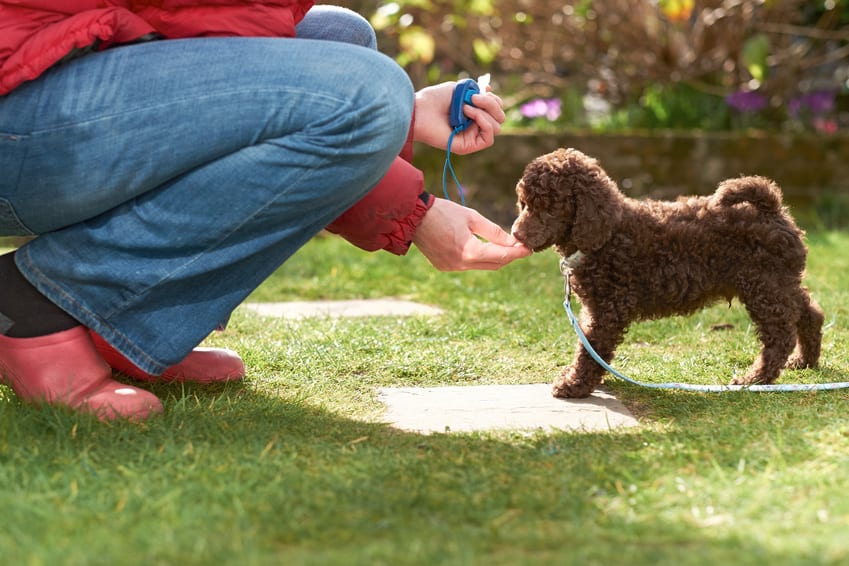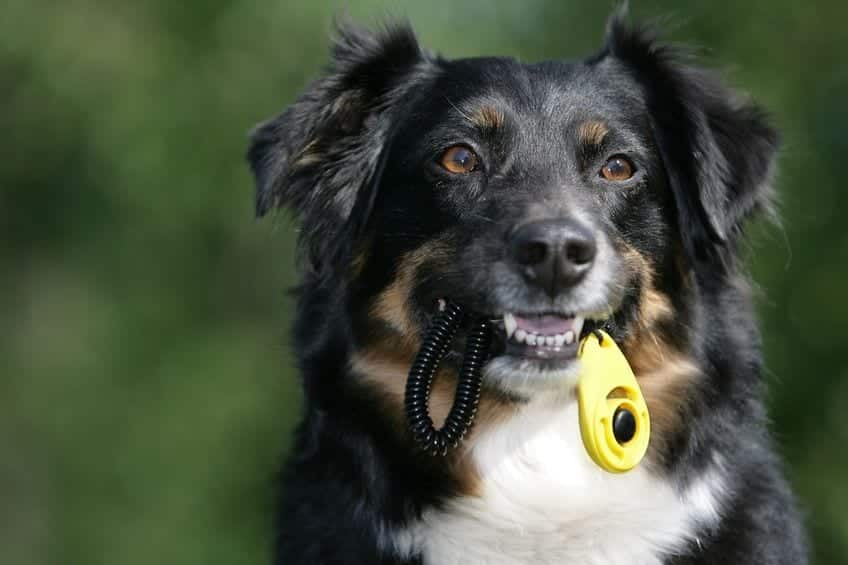Clicker training with dogs
If you're looking for a proven method that doesn't use force, fear or intimidation, you've come to the right place. You've adopted a dog, he's nice, cute and the best dog in the world but.....he doesn't obey and does a little bit of everything and anything?
I know this situation all too well. A dog that sits down when you say "lie down", a dog that when you call him goes the other way and so on and so forth and it's a real pain in the ass that sets in on a daily basis.
But I'm sure you want this to change and are full of hope when you look at your fur ball. I managed to teach my dog the basic commands.
And then I got interested in the clicker training method. And if I talk to you about it, it's because I know that it's an efficient training technique because I tested it on my mother-in-law's dog. Besides, more and more professional trainers are using clicker training. That's saying a lot!
So I tell you everything about the origin of this method, its principles and of course, how to train your dog with this little magic box.
The History of Clicker Training
Like conventional training, clicker training is a new way of communicating with your dog. It was developed at the end of World War II. It was so effective in learning new behaviors that it was first used on pigeons and then on dolphins.
After the war, the clicker was integrated into the world of marine shows. If you have ever been to a marine show, you have certainly heard the "click" sound that allows dolphin trainers to make them do tricks. But it was not until the 70's and 80's that the clicker appeared in the dog world.
Karen Pryor, who is a reference in the field of marine biology and behavioral psychology, developed this method in the USA for dog training.
And for some years now, the method is more and more used for dog training.

The principle of clicker training
The clicker is a small box that makes a metallic noise when pressed (the famous click). It is in fact a means of communication between you and your dog and an excellent learning method.
It is a gentle method where the dog is the actor of his training. This means that the dog will suggest various behaviors that will trigger the clicker or not. The dog will gradually learn that the noise emitted by the clicker indicates that he has behaved well and that he will therefore be rewarded. He becomes a participative and attentive companion to the training and will learn very quickly to have the behavior desired by his master.
I would like to point out that a clicker is not a command. It is just a signal that he has done a command correctly and that a reward will follow. It is important to know this.

Basic clicker training techniques
Now it's time for me to tell you all about clicker training. You'll see that this method may seem "weird" at first, but you'll also see that training your dog has never been easier than with the clicker.
First step: familiarize your dog with the clicker
This is an important phase of the method. Its principle is simple. We know that the dog makes associations in his head. Clicker training takes this into account. You will have to get your dog used to the sound of the clicker and make him understand that a click means that a reward is coming.
For the first few times, here's what I recommend: you throw a treat on the floor and click when he takes it. You repeat this step several times. Don't wait to give him the reward.
Another example: if you want your dog to learn to lie down on demand, lure him down with a treat. When his body is completely on the ground, you activate the clicker. This is the luring technique.
The second step: training
Did your dog understand what the click meant? Great, you're well on your way. Now you can continue the training by adding the command word (sit, stay, etc.) or the gesture.
He lies down, you activate the clicker and give him the reward. He sits, you click and give him a reward. And so on, whatever order you want to teach him. And you will see that as the sessions go on, he will repeat the behavior by himself to trigger the click and thus get his reward. This technique is called capturing.
The more the days go by, the faster your pet will learn and the more enthusiastic he will be about being rewarded but also about pleasing you.
The last step: the end of training
I assure you, you won't have to carry the clicker in your pocket for the rest of your life, nor the treats. To your dog's chagrin, the rewards are not for life. The next step is for your dog to obey, without the clicker and without the rewards.
Once your dog understands the command and does it every time you activate the clicker, you can begin to decrease the use of the clicker. Does he sit when you ask? Reward him. Just that. Without the clicker. It's not easy at first, but I have faith in you and especially in your dog. And little by little, remove the reward. It takes time but it's a necessary step. The command word or the gesture will replace the click in a natural way.
Tips for successful dressing
After having tested this method several times on different dogs, I want to share with you my experience, my advice, what to do and what not to do.
As I told you, each click must be associated with a reward. If you ever make a click by mistake, reward your dog anyway, it's not serious. The important thing is that the clicker does not lose its importance in the dog's eyes.
Be precise when you activate the clicker. The more precise you are, the more cues the dog will have.
Don't put your dog through long training sessions. Fatigue will dampen his motivation. In fact, if you want to train your dog, you can do it in only 15 minutes a day. You don't believe me (grrr)? Look at this method and you will see that it is feasible and even recommended.
Don't always do the sessions in the same place. Vary the places so that your dog can adapt to all situations and environments.
With this method, there is no force, pain, intimidation or raising of voices. However, you can decide not to reward the dog if his behavior is not good. Some trainers will give you this advice. I have never used it because to me, click = reward.
No one works for free, including a dog. I am all for using food in the form of treats as a reward. But it doesn't have to last for weeks. Once the command is understood, the reward can be not a treat but a caress, a toy, compliments etc.
Don't go too fast. You have to let the dog get used to the clicker and you have to take the time to master the techniques of the method.
Conclusion
So what do you think of this method? Does it tempt you? In any case, I recommend it to you and all the dogs I know too. After all, learning with only rewards, who wouldn't be happy? With regular but not too long sessions, a good control of the clicker, some treats or caresses, you will succeed in training your dog!


